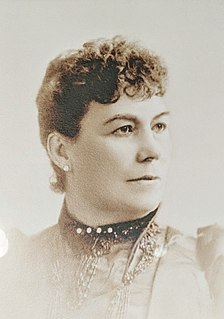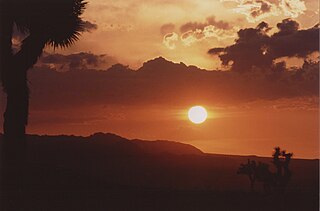
Calico is a ghost town and former mining town in San Bernardino County, California, United States. Located in the Calico Mountains of the Mojave Desert region of Southern California, it was founded in 1881 as a silver mining town, and today has been converted into a county park named Calico Ghost Town. Located off Interstate 15, it lies 3 miles (4.8 km) from Barstow and 3 miles from Yermo. Giant letters spelling CALICO can be seen on the Calico Peaks behind the ghost town from the freeway. Walter Knott purchased Calico in the 1950s, architecturally restoring all but the five remaining original buildings to look as they did in the 1880s. Calico received California Historical Landmark #782, and in 2005 was proclaimed by then-Governor Arnold Schwarzenegger to be California's Silver Rush Ghost Town.
The Ancient and Honorable Order of E Clampus Vitus (ECV) is a fraternal organization dedicated to the preservation of the heritage of the American West, especially the history of the Mother Lode and gold mining regions of the area. There are chapters in California, Nevada, Arizona, Colorado, Utah, Washington, Idaho, Oregon, Montana and Outposts in other western states. Members call themselves "Clampers." The organization's name is in Dog Latin, and has no known meaning; even the spelling is disputed, sometimes appearing as "Clampus," "Clampsus," or "Clampsis." The motto of the Order, Credo Quia Absurdum, is generally interpreted as meaning "I believe it because it is absurd;" the proper Latin quotation Credo quia absurdum est, is from the Christian apologist Tertullian, who rejected rationalism and accepted a Gospel which addressed itself to the "non-rational levels of perception."
Bagdad is a ghost town in the Mojave Desert, in San Bernardino County, California.

Daggett is an unincorporated community located in San Bernardino County, California in the United States. The town is located on Interstate 40 ten miles (16 km) east of Barstow. The town has a population of about 200. The ZIP code is 92327 and the community is inside area code 760.

Searles Lake is an endorheic dry lake in the Searles Valley of the Mojave Desert, in northwestern San Bernardino County, California. The lake in the past was also called Slate Range Lake and Borax Lake.

Newberry Springs is an unincorporated community in the western Mojave Desert of Southern California, located at the foot of the Newberry Mountains in San Bernardino County, California, United States. The population at the 2000 census was 2,895.

Sarah Clark Kidder was president of Northern California's Nevada County Narrow Gauge Railroad (NCNGRR) from 1901 to 1913. She was the first female railroad president in the world.

Ludlow is an unincorporated community in the Mojave Desert on Interstate 40, located in San Bernardino County, California, United States. The older remains of the ghost town are along historic Route 66.

Vanderbilt was a short-lived gold mining town located in San Bernardino County, California, United States. It existed between 1893 and 1895. At its peak it may have had a population of about 400 people.

Hart was a short-lived gold mining town located in the Mojave desert, in San Bernardino County, California. It existed between 1908 and 1915, and was located on the northeastern edge of Lanfair Valley near the New York Mountains. The area is now in the Castle Mountains National Monument, administered by the National Park Service.

High Desert is an informal designation, with non-discrete boundaries, applied to areas of the Mojave Desert in southern California that are generally between 2,000 feet (610 m) and 4,000 feet (1,200 m) in elevation, and located just north of the San Gabriel, San Bernardino and Little San Bernardino Mountains.

Siberia is a ghost town in the Mojave Desert of San Bernardino County, California, United States. It lies along historic Route 66 between Bagdad and Ludlow, in the ZIP code 92357 and area codes 442 and 760. Siberia has been noted for its unusual place name.

North Bloomfield is a small unincorporated community located in Nevada County, California.

Belleville, California was a gold mining boomtown in the San Bernardino Mountains of San Bernardino County, California. The settlement grew up rapidly following the discovery of gold by William F. Holcomb in Holcomb Valley early 1860. Which helped the town challenge the seat of San Bernardino County. Belleville was named after Belle, the first child born in the new town. It was a busy mining town for ten years, it was virtually abandoned before the end of the 19th century. It is now a ghost town.

Barnwell, originally a rail camp named Summit, then Manvel, was a former railhead serving local mining camps, now a ghost town, in San Bernardino County, California. It lies at an elevation 4806 feet in the New York Mountains.
Hedges, later renamed Tumco, is a locale, a ghost town, site of a former mining town, in Imperial County, California. It lies at an elevation of 617 feet / 188 meters along the Tumco Wash in the Cargo Muchacho Mountains. Nearby is the Hedges Cemetery at an elevation of 643 feet / 196 meters, at 32°53′04″N114°49′52″W.

The Camp Coxcomb was a sub camp of the US Army Desert Training Center in Riverside County, California. The main headquarters for the Desert Training Center was Camp Young were General Patton's 3rd Armored Division was stationed. Camp Coxcomb was designated a California Historic Landmark (No.985). The site of the Camp Granite is 45 miles East of Indio, California off Interstate 10 and California State Route 177 near the Coxcomb Mountains. The train stop at Freda railroad siding delivered Troops and equipment. The camp closed in early in 1944 after about two years of operations.

The Camp Goffs was a sub camp of the US Army Desert Training Center in Riverside County, California. The main headquarters for the Desert Training Center was Camp Young, this is where General Patton's 3rd Armored Division was stationed. Camp Goffs was designated a California Historic Landmark (No.985). The site of the Camp Goffs just north at the former Santa Fe Railroad station at Goffs, California. Goffs, California is on U.S. Route 66 5 miles north of the current Interstate 40, 25 miles (40 km) west of Needles in San Bernardino County, California. Currently at the south east end of the Mojave National Preserve. Camp Goffs was 20 miles southeast of Camp Essex and Camp Clipper.

The Chimney Rock was designated a California Historic Landmark (No.737) on June 6, 1960. Chimney Rock is located near Lucerne Valley, California in the mountains north of the Rabbit Springs Dry Lake and of California State Route 18 near the Rabbit Springs Road junction. It is the site of the last battle between immigrant settlers and a Native American tribe in the Mojave Desert. Conflicts between Indians and white settlers over the rich lands of the San Bernardino Mountains ended in the battle at Chimney Rock on February 16, 1867. The Indians defended themselves against the settlers. But in the end they retreat into the desert. This ended the mountain food gathering of the Indians. A historical marker is beside Highway 18, next to the welcome sign on the town's western border.

The Potash wars were a series of events that took place from 1910 to 1915 in the Searles Valley near Searles Lake, a dry lake, near the current town of Trona in the San Bernardino County of California. The Potash wars gain national and international news at the time due to the involvement of famous lawman Wyatt Earp and the importance of the valley's supply of potash at the time. Potash is an important crop fertilizer and the Searles Valley was a major supplier in the 1910s.











